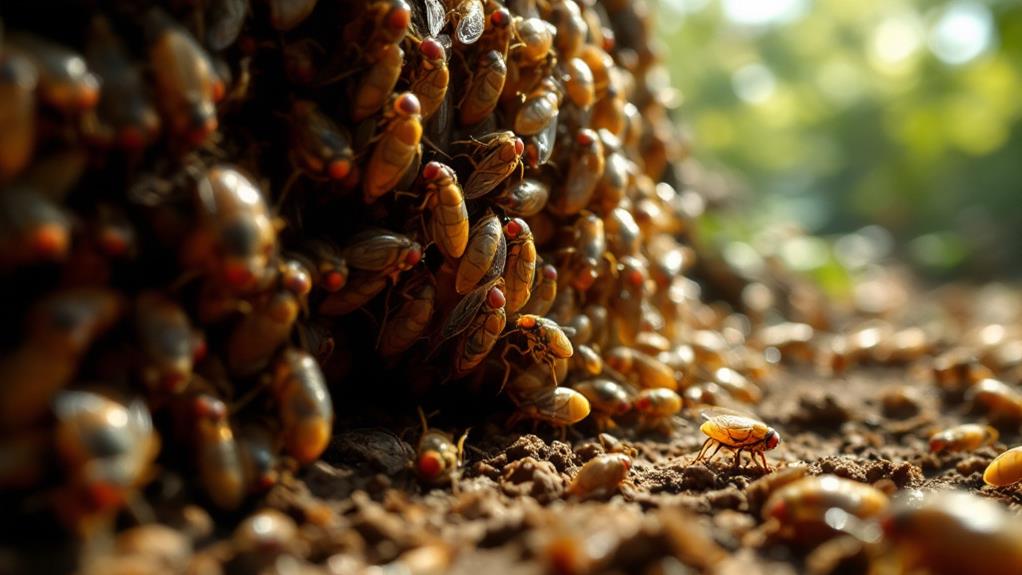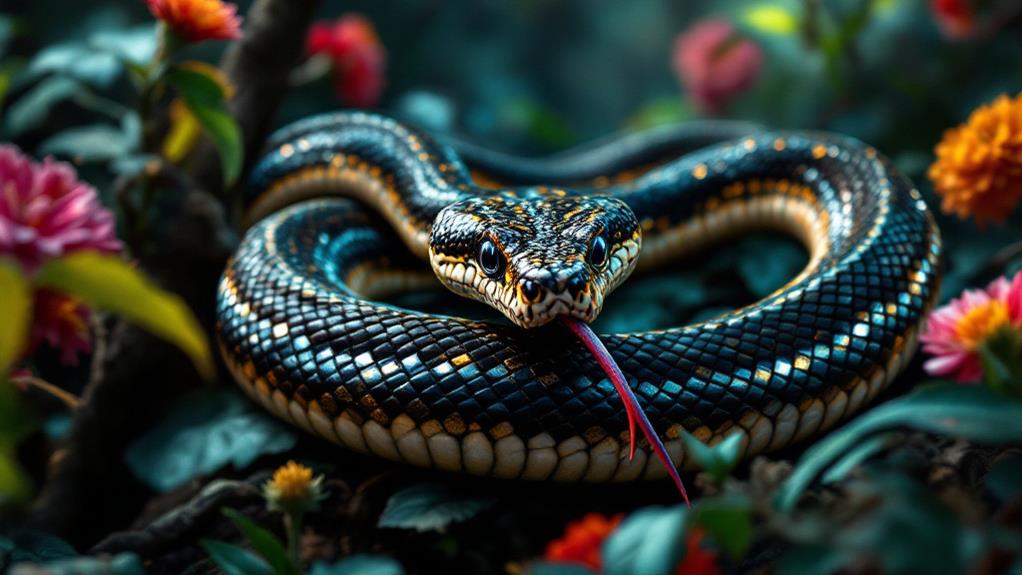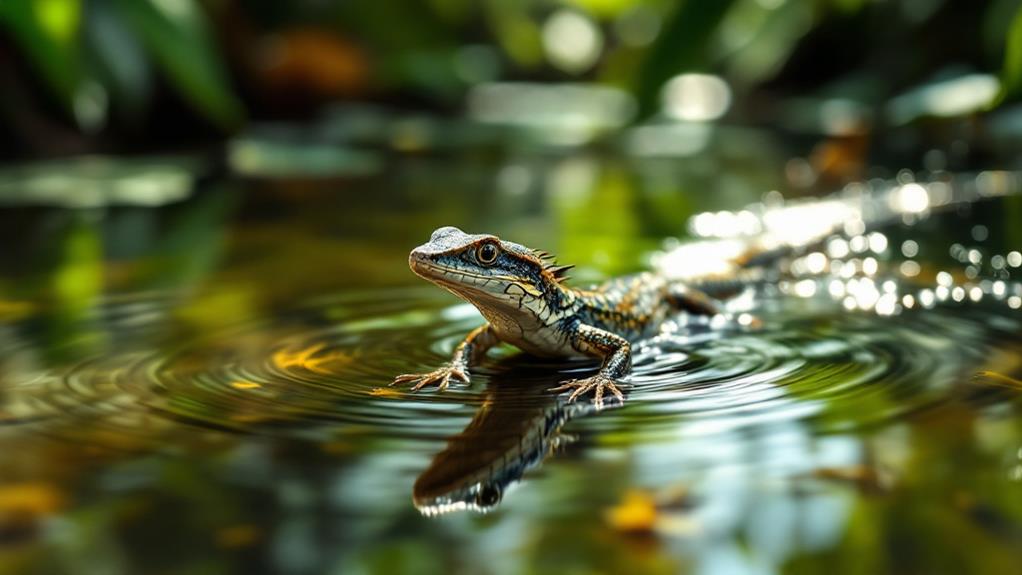Strange Animal Behavior: Bizarre Behaviors That Defy Explanation

You'll uncover a world of astonishing animal behaviors that challenge our understanding of nature. From the myth-busting truth about lemmings to the intricate waggle dance of honeybees, these creatures never cease to amaze. Humpback whales demonstrate teamwork with their bubble net feeding technique, while lyrebirds showcase uncanny mimicry skills. Flamingos perplex scientists with their one-legged stance, and anglerfish exhibit extreme sexual dimorphism. Perhaps most bizarre are cicadas, emerging en masse after 17 years underground. These fascinating behaviors offer just a glimpse into the complex and often inexplicable world of animal adaptations. Prepare to have your mind blown by nature's oddities.
Lemming Mass Migration Myths
Despite popular belief, lemmings don't commit mass suicide by jumping off cliffs. This misconception about their supposed suicidal tendencies has persisted for decades, fueled by misrepresented media portrayals and exaggerated folklore. In reality, these small rodents exhibit fascinating migratory behaviors that have been misinterpreted as self-destructive acts.
You might wonder how this myth originated. It stems from the lemmings' periodic population explosions, followed by mass migrations in search of new habitats. During these treks, some lemmings may fall into rivers or off cliffs accidentally, but it's not a deliberate act. The herd mentality myths surrounding lemmings have been further perpetuated by a controversial 1958 Disney documentary that staged lemming "suicides" for dramatic effect.
Contrary to popular belief, lemmings are actually quite adept at swimming and can cross bodies of water safely. Their relocations are driven by natural population cycles and the need to find new food sources. By understanding the truth behind lemming behavior, you can appreciate the complexity of their survival strategies and dispel the unfounded notion of their self-destructive nature.
Honeybee Waggle Dance
The honeybee waggle dance is one of nature's most fascinating communication systems. You'll be amazed to learn that these tiny insects can convey complex information about food sources to their hive mates through a series of intricate movements. When a forager bee locates a rich nectar or pollen source, it returns to the hive and performs this unique dance on the vertical surface of the honeycomb.
The waggle dance communication consists of a figure-eight pattern, with the bee waggling its abdomen during the straight run. The angle of this run relative to the vertical indicates the direction of the food source in relation to the sun, while the duration of the waggle indicates the distance. Other bees in the hive interpret this dance to pinpoint the food source accurately.
This exceptional behavior isn't limited to food sources; it's also pivotal in hive swarming behavior. When a colony needs to relocate, scout bees perform waggle dances to communicate potential new hive locations. The intensity and frequency of these dances help the swarm collectively decide on the best new home.
Humpback Whale Bubble Net Feeding

During their annual feeding season, humpback whales exhibit an extraordinary cooperative hunting technique known as bubble net feeding. You'll be amazed at how these massive creatures work together to trap and consume their prey.
Humpback whale feeding strategies are diverse, but bubble net feeding stands out as one of the most fascinating. A group of whales will plunge deep and circle a school of fish, blowing bubbles as they swim upward in a spiral pattern. This creates a "net" of bubbles that confuses and traps the fish.
As the bubble net constricts, one whale will emit a high-pitched feeding call, signaling the others to swim upward with their mouths open. They'll burst through the surface, engulfing thousands of fish in a single gulp.
Bubble net hunting techniques vary among different whale populations, with some groups using unique adaptations. For instance, Alaskan humpbacks have been observed using their flippers to herd fish into the bubble net, increasing their catch.
This behavior showcases the intelligence and teamwork of humpback whales, demonstrating how these animals have evolved sophisticated methods to maximize their feeding efficiency in challenging ocean environments.
Lyrebird's Uncanny Mimicry Abilities
Among the world's most talented vocal mimics, lyrebirds possess an extraordinary ability to replicate a vast array of sounds from their environment. You'd be amazed to hear these Australian natives imitate not only other birds but also human-made noises with astonishing accuracy. Their vocal repertoire expansion seems limitless, as they've been known to mimic chainsaws, car alarms, and even camera shutters.
What's truly exceptional is the lyrebird's capacity for cross-species mimicry. They don't just copy other birds; they'll imitate anything that catches their ear. You might hear a lyrebird perfectly replicating the call of a kookaburra one moment and a dog's bark the next. This uncanny ability isn't just for show – it's believed to play a pivotal role in their mating rituals and territorial displays.
Scientists are still puzzled by how lyrebirds achieve such precise imitations. Their unique vocal apparatus allows them to produce a wide range of frequencies, but the cognitive processes behind their mimicry remain a mystery. As you listen to a lyrebird's performance, you're witnessing one of nature's most impressive and perplexing behaviors.
Flamingo's One-Legged Stance Mystery

While lyrebirds enthrall us with their vocal prowess, flamingos intrigue scientists with their peculiar balancing act. You've likely seen these pink-feathered birds standing on one leg, but have you ever wondered why? The flamingo's one-legged posture dynamics have probed researchers for years.
Scientists have uncovered that this stance isn't just for show. It's actually one of nature's clever energy conservation strategies. When you observe a flamingo closely, you'll notice they can maintain this position for hours without visible effort. Their unique anatomy allows them to lock their leg joints, reducing muscle strain and energy expenditure.
You might think standing on two legs would be more stable, but for flamingos, the opposite is true. Their one-legged stance minimizes body sway, helping them maintain balance even in strong winds or water currents. This posture also helps regulate their body temperature by reducing heat loss through their legs.
Despite extensive research, some aspects of this behavior remain mysterious. Scientists continue to study flamingos to fully understand the biomechanics and evolutionary advantages of their iconic one-legged stance.
Anglerfish's Extreme Sexual Dimorphism
Rarely do you encounter a creature with such extreme differences between males and females as the anglerfish. This deep-sea dweller exhibits one of the most bizarre mating adaptations in the animal kingdom. While females can grow up to 60 times larger than males, it's the male's peculiar behavior that'll truly astound you.
When a male anglerfish finds a female, he bites into her body and literally fuses with her. His body degenerates until he's nothing more than a pair of gonads attached to the female. This strange union guarantees a constant supply of sperm for the female, who can mate with multiple males simultaneously. It's an energy-efficient reproduction strategy that's perfectly suited to the challenges of the deep sea.
You might wonder why evolution favored such an extreme form of sexual dimorphism. The answer lies in the harsh environment where anglerfish live. Food is scarce, and finding a mate is difficult. By becoming permanent parasites, males ensure their genetic legacy while females gain a reliable source of sperm without expending energy searching for mates.
Cicada's 17-Year Life Cycle

In contrast to the anglerfish's unusual mating habits, cicadas have developed a remarkably long-term survival strategy. You might be familiar with the deafening buzz that fills the air every few years, but did you know that some cicada species spend 17 years underground before emerging?
These fascinating insects have honed the art of patience. As soon as they hatch, cicada nymphs burrow into the soil, where they'll spend nearly two decades feeding on tree root sap. When the time is right, millions of cicadas emerge simultaneously in a spectacular display known as the cicada's synchronized emergence.
This coordinated event isn't just for show. It's a clever survival tactic that overwhelms predators with sheer numbers, ensuring that enough cicadas survive to mate and lay eggs. The cicada's seasonal adaptation is finely tuned to environmental cues, such as soil temperature and moisture levels. When conditions are perfect, they'll crawl out of the ground, shed their exoskeletons, and take to the trees for a brief but intense mating frenzy. After just a few weeks above ground, they'll die, leaving their offspring to continue the cycle.



